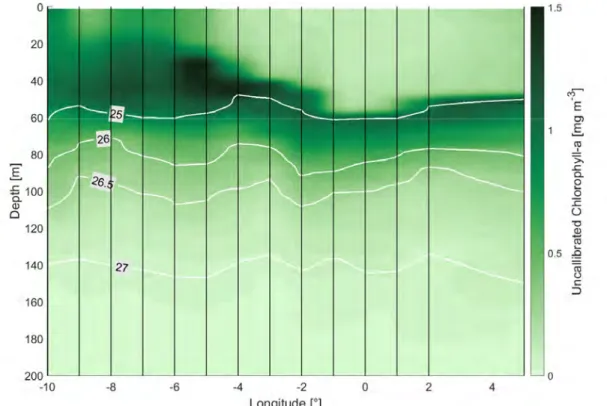Prof. Dr. Peter Brandt Meteor-Reise 158
3
rdWeekly Report M158, Walvis Bay-Recife
Sep. 30 - Oct. 6, 2019
At the end of the second week we arrived at the equator west of São Tomé, where we began interdisciplinary on-station and underway measurements. Here, Meteor cruise M158 is focused on a better understanding of equatorial upwelling, its physical forcing, its importance for biological productivity and plankton communities, its associated biogeochemical cycles, and the flow regime that sets the background for the export flux. A particular focus is the study of the carbon export to greater depths due to particle transport and daily vertical zooplankton migration. The physical ocean dynamics is studied with shipboard and on-station velocity and tracer measurements and is intended to allow a quantification of the ventilation and water mass exchange between the western and eastern equatorial Atlantic. The work on the equator is part of a European collaborative project addressing South and Tropical Atlantic climate- based marine ecosystem prediction for sustainable management (EU TRIATLAS). So far, our knowledge of the status of the South and Tropical Atlantic marine ecosystems and their future evolution is poor, especially in comparison to the North Atlantic, and impedes the understanding of the whole Atlantic. These knowledge gaps represent a major challenge for the sustainable management of human activities that affect marine ecosystems.
The station work began at the equator at 5°E in the territorial waters of São Tomé and Príncipe and was continued at 2°E outside the territorial waters of Equatorial Guinea with a station spacing of 1° longitude. Station work often includes 2 CTD stations to meet the needs of different working groups for water samples from different depths.
Plankton net stations and microstructure measurements complements the on-station work. Of particular importance are the velocity measurements with the shipboard acoustic Doppler current meters. They show the very energetic flow of the equatorial undercurrent, sometimes with velocities larger than 1 m/s within its core at about 80 m water depth (Fig. 1). With the velocity observations, we want to observe the intraseasonal waves, which are noticeable at the equator by north and south currents and have zonal wavelengths of 800 to 1000 km. These waves are thought to propagate their energy downward to feed long-period oscillations of the deep equatorial Atlantic.
The eastern equatorial Atlantic is characterized by strong near-surface water mass changes: while in the eastern part close to the African continent warm and fresh water masses hosting low biological productivity dominate, farther to the west, surface waters are cooler and more saline (Fig. 2). Here within the equatorial upwelling region, high chlorophyll concentrations can be observed up to the surface (Fig. 3).
Prof. Dr. Peter Brandt Meteor-Reise 158
Fig. 1: (a) Zonal and (b) meridional velocity component along the equator. The eastward Equatorial Undercurrent having core velocities above 1 m/s is among the strongest currents in the tropical Atlantic (Rodrigue Anicet Imbol Koungue).
Fig. 2: Salinity and temperature in the upper 200m. West of 5°W we observed lower temperatures and higher salinities near the surface that are associated with the equatorial upwelling. The EUC transports salinity maximum waters from the western to the eastern equatorial Atlantic (Arthur Prigent).
While the Atlantic Ocean is probably the best studied ocean basin overall, biological processes in the Equatorial Atlantic are poorly understood with few measurements of microbial community structure or biogeochemical rates. This is especially true of the
“upwelling season” in the boreal summer when almost no measurements exist. The little understanding we have of this apparently most productive time of year for the region come from satellite observations and models. For example, Longhurst (1993) used satellite data to estimate that the tropical Atlantic Ocean (10°N–10°S) contributed more to global carbon fixation than the entire North Atlantic spring bloom region but this estimate has never been validated. Meteor cruise M158 is a unique cruise to study the late summer equatorial dynamics and to understand how the various physical processes affect the supply of nutrients to the upper water column and the subsequent phytoplankton response. Measurements of bacteria, Prochlorococcus, Synechococcus,
Prof. Dr. Peter Brandt Meteor cruise 158
and picoeukayote abundance are being made using a flow cytometer. Additionally, phytoplankton diagnostic pigments are being measured using the HPLC technique to quantify the phytoplankton community. Rates of primary production are made using 14C and 13C tracer techniques and rate of nitrogen fixation is made using the 15N tracer technique. The photophysiological status of phytoplankton are made both continuously using the underway sampling system as well as profiles using water from the CTD niskin bottles every 1° longitude. Initial results show that the highest rates of carbon fixation, even in apparently nutrient rich waters is from small phytoplankton which is contrary to model predictions.
Fig. 3: Fluorescence measurements at the CTD show variable chlorophyll concentrations along the equator (Peter Dennert).
Meanwhile, we have reached the equator at 14°W and thus already the slopes of the Mid-Atlantic Ridge that separates the eastern basin of the Atlantic from the western basin. Overall, the daily routine is determined by the station work. Transit times between the stations are used to analyse water samples and data obtained or to present and discuss our results in seminars and discussions. At the beginning of next week, we will celebrate already our half-way party.
Greetings from the tropics in the name of the cruise participants of M158, Peter Brandt
GEOMAR Helmholtz Centre for Ocean Research Kiel

